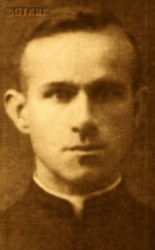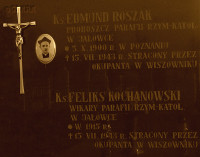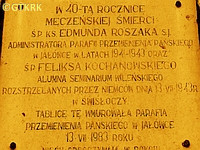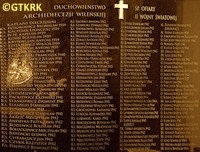Roman Catholic
St Sigismund parish
05-507 Słomczyn
85 Wiślana Str.
Konstancin deanery
Warsaw archdiocese, Poland
full list:
displayClick to display full list

searchClick to search full list by categories
wyświetlKliknij by wyświetlić pełną listę po polsku

szukajKliknij by przeszukać listę wg kategorii po polsku

Martyrology of the clergy — Poland
XX century (1914 – 1989)
personal data
surname
KOCHANOWSKI
forename(s)
Felix (pl. Feliks)
function
diocesan seminarian
creed
Latin (Roman Catholic) Church RCmore on
en.wikipedia.org
[access: 2014.09.21]
diocese / province
Vilnius archdiocesemore on
en.wikipedia.org
[access: 2013.05.19]
date and place
of death
15.07.1943

Svislachtoday: Svislach dist., Grodno reg., Belarus
more on
en.wikipedia.org
[access: 2021.09.29]
alt. dates and places
of death
13.07.1943
details of death
After German and Russian invasion of Poland in 09.1939 and start of the World War II, after German attack on 22.06.1941 of their erstwhile ally, Russians, and start of German occupation, arrested by the Germans on 03.03.1942 together with professors and seminarians of Vilnius Theological Seminary.
Jailed in Lukiškės prison in Vilnius.
On 05.05.1942 transported to Germany for a slave forced manual labour.
During transport escaped in Grodno.
Went home and settled in the Jałówka parish rectory (Fr Edmund Roszak was a parish priest there).
There arrested again on 13.07.1943.
Jailed in Svislach and murdered couple of days later in a mass murder — part of German extermination plan of Polish intelligentsia of Białystok region, called «Black July» 1943 — together with three other priests, including Fr Roszak, in a small Wishovnik forest, c. 2 km form centre of Svislach.
cause of death
mass murder
perpetrators
Germans
sites and events
Wiszownik forestClick to display the description, «Black July» 1943Click to display the description, Slave labour in GermanyClick to display the description, Vilnius (Lukiškės)Click to display the description, 03.03.1942 arrests (Vilnius)Click to display the description, Ribbentrop‐MolotovClick to display the description, Pius XI's encyclicalsClick to display the description
date and place
of birth
27.04.1907Birth certification on:
photos.szukajwarchiwach.gov.pl
[access: 2025.04.13]

Łapiczetoday: Krynki gm., Sokółka pov., Podlaskie voiv., Poland
more on
en.wikipedia.org
[access: 2022.01.06]
parents
KOCHANOWSKI John
🞲 ?, ? — 🕆 ?, ?

KLIMOWICZ Emily
🞲 ?, ? — 🕆 ?, ?
baptism
29.04.1907Birth certification on:
photos.szukajwarchiwach.gov.pl
[access: 2025.04.13]

Krynkitoday: Krynki gm., Sokółka pov., Podlaskie voiv., Poland
more on
en.wikipedia.org
[access: 2022.01.06]
St Anne RC church
positions held
from 1941
student — Vilniustoday: Vilnius city dist., Vilnius Cou., Lithuania
more on
en.wikipedia.org
[access: 2022.01.06] ⋄ philosophy and theology, Theological Seminary
others related
in death
BESZTA–BOROWSKIClick to display biography Anthony, BURAKClick to display biography Mark, KLIMCZAKClick to display biography Michael Eugene (Fr Dennis), KOZŁOWSKIClick to display biography Joseph, KUŹMICKIClick to display biography Witold, OLSZEWSKIClick to display biography Louis, OPIATOWSKIClick to display biography Henry, PĘZAClick to display biography Alexander, PŁOŃSKIClick to display biography Joseph, ROSZAKClick to display biography Edmund, RUTKOWSKIClick to display biography Bronislav, SKOKOWSKIClick to display biography Justin, SZULCClick to display biography Joseph, SZYPIŁŁOClick to display biography Casimir, OGANOWSKIClick to display biography Francis, PIÓRKOClick to display biography Augustine, SOKOŁOWSKIClick to display biography Joseph, WASILEWSKIClick to display biography Anastasius, WENTAClick to display biography Steven, ŻYŹNIEWSKIClick to display biography Henry
sites and events
descriptions
Wiszownik forest: In the Wiszownik forest c. 2 km from Svislach on 15.07.1943 (or 13.07.1943 according to some sources) Germans murdered, as part of their extermination program against partisans, approx. 55 Poles, mainly from Wołkowysk county, jailed as „captive hostages”. Among the victims were 4 local priests. Earlier, in 11.1942, the Germans murdered c. 1,536 Jews from the Svislach area in the same place. (more on: www.flickr.comClick to attempt to display webpage
[access: 2013.10.05])
«Black July» 1943: On 20.05.1943 East Prussia German Germ. Gauleiter (Eng. regional leader), Erich Koch, nominated Otton Helwig a new German commander of SS und Polizeiführer (Eng. SS and police commander) of Bezirk (Eng. region) Białystok. He immediately initiated a pacification action ostensibly targeted at Polish partisans. The real aim was intimidation of the Poles from Białystok region and extermination of its leading classes. Herbert Zimmermann, security police and SD commanded, deputy commander of Einsatzgruppen SS (Eng. Operational Groups) for Germ. Bezirk (district) Bialystok, issued an order to arrest and execute 19 people, physicians, barristers, city staff and teacher, including their families, in each all county cities of the district. On 10.07.1943 a „Commando Müller” (from the surname of its murderous commander, prob. Hermann Müller), consisting of Belarus support batallion, Lithuanian units dressed in German uniforms, German Gendarmerie and police and German Gestapo members, perpetrated a series of mass murders in various places in Bezirk Białystok (including its Łomża and Grodno regions). In 07.1943 Germans murdered more than 1,000 people (prob. near 2,000). On 15.07.1943 only in all county seats of Bezirk Bialystok at least 9 local Polish intelligentsia families, including women, children and old were selected and murdered. Among the victims were many priests: in executions in Pilice forest, Wiszownik forest, Kosówka forest, Navumavichy, Jeziorka, etc. Germans murdered at least 15 clerics. (more on: www.swzygmunt.knc.plClick to attempt to display webpage
[access: 2019.10.13])
Slave labour in Germany: During World War II Germans forced c. 15 million people to do a slave forced labour in Germany and in the territories occupied by Germany. In General Governorate the obligation to work included Poles from 14 to 60 years old. On the Polish territories occupied and incorporated into Germany proper obligation was forced upon children as young as 12 years old — for instance in Warthegau (Eng. Greater Poland). (more on: en.wikipedia.orgClick to attempt to display webpage
[access: 2017.11.07])
Vilnius (Lukiškės): Vilnius prison used both by Russians and Germans. Thousands of Poles were kept there. From 2,000 to 16,000 prisoners were jailed at any time there. In 06.1941, after German invasion, Russians murdered most of the prisoners. (more on: en.wikipedia.orgClick to attempt to display webpage
[access: 2021.07.04])
03.03.1942 arrests (Vilnius): On 03.03.1942 in Vilnius Germans arrested 28 professors and 81 seminarians of Vilnius Theological Seminary, prob. denounced by the Lithuanians. A few weeks later, on 26.03.1942, the Germans and the Lithuanians who collaborated with them arrested 9 religious fathers, 5 brothers, 2 novices and 1 boy helping in the kitchen, from the Jesuit College of Vilnius. All were locked in Lukiškės prison in Vilnius. Professors were on 18.03.1942 transported to Wyłkowyszki and interned there. In 10.1942 were subsequently sent to concentration camp (i.e. Szałtupie, IL Panevėžiukas). The seminarians were transported out on 04.05.1942 to Germany for slave labour (most of them escaped during the transport). Theological seminary was closed. Few weeks after Vilnius seminary arrests, on 26.03.1942 Germans arrested Vilnius religious friars and clerics (Jesuits and Missionary Fathers of St Vincent a Pauli, among others) who got exposed to the same prison treatment. (more on: www.tygodnik.ltClick to attempt to display webpage
[access: 2013.05.19])
Ribbentrop‐Molotov: Genocidal Russian‐German alliance pact between Russian leader Joseph Stalin and German leader Adolf Hitler signed on 23.08.1939 in Moscow by respective foreign ministers, Mr. Vyacheslav Molotov for Russia and Joachim von Ribbentrop for Germany. The pact sanctioned and was the direct cause of joint Russian and German invasion of Poland and the outbreak of the World War II in 09.1939. In a political sense, the pact was an attempt to restore the status quo ante before 1914, with one exception, namely the „commercial” exchange of the so‐called „Kingdom of Poland”, which in 1914 was part of the Russian Empire, fore Eastern Galicia (today's western Ukraine), in 1914 belonging to the Austro‐Hungarian Empire. Galicia, including Lviv, was to be taken over by the Russians, the „Kingdom of Poland” — under the name of the General Governorate — Germany. The resultant „war was one of the greatest calamities and dramas of humanity in history, for two atheistic and anti‐Christian ideologies — national and international socialism — rejected God and His fifth Decalogue commandment: Thou shall not kill!” (Abp Stanislav Gądecki, 01.09.2019). The decisions taken — backed up by the betrayal of the formal allies of Poland, France and Germany, which on 12.09.1939, at a joint conference in Abbeville, decided not to provide aid to attacked Poland and not to take military action against Germany (a clear breach of treaty obligations with Poland) — were on 28.09.1939 slightly altered and made more precise when a treaty on „German‐Russian boundaries and friendship” was agreed by the same murderous signatories. One of its findings was establishment of spheres of influence in Central and Eastern Europe and in consequence IV partition of Poland. In one of its secret annexes agreed, that: „the Signatories will not tolerate on its respective territories any Polish propaganda that affects the territory of the other Side. On their respective territories they will suppress all such propaganda and inform each other of the measures taken to accomplish it”. The agreements resulted in a series of meeting between two genocidal organization representing both sides — German Gestapo and Russian NKVD when coordination of efforts to exterminate Polish intelligentsia and Polish leading classes (in Germany called «Intelligenzaktion», in Russia took the form of Katyń massacres) where discussed. Resulted in deaths of hundreds of thousands of Polish intelligentsia, including thousands of priests presented here, and tens of millions of ordinary people,. The results of this Russian‐German pact lasted till 1989 and are still in evidence even today. (more on: en.wikipedia.orgClick to attempt to display webpage
[access: 2015.09.30])
Pius XI's encyclicals: Facing the creation of two totalitarian systems in Europe, which seemed to compete with each other, though there were more similarities than contradictions between them, Pope Pius XI issued in 03.1937 (within 5 days) two encyclicals. In the „Mit brennender Sorge” (Eng. „With Burning Concern”) published on 14.03.1938, condemned the national socialism prevailing in Germany. The Pope wrote: „Whoever, following the old Germanic‐pre‐Christian beliefs, puts various impersonal fate in the place of a personal God, denies the wisdom of God and Providence […], whoever exalts earthly values: race or nation, or state, or state system, representatives of state power or other fundamental values of human society, […] and makes them the highest standard of all values, including religious ones, and idolizes them, this one […] is far from true faith in God and from a worldview corresponding to such faith”. On 19.03.1937, published „Divini Redemptoris” (Eng. „Divine Redeemer”), in which criticized Russian communism, dialectical materialism and the class struggle theory. The Pope wrote: „Communism deprives man of freedom, and therefore the spiritual basis of all life norms. It deprives the human person of all his dignity and any moral support with which he could resist the onslaught of blind passions […] This is the new gospel that Bolshevik and godless communism preaches as a message of salvation and redemption of humanity”… Pius XI demanded that the established human law be subjected to the natural law of God , recommended the implementation of the ideal of a Christian state and society, and called on Catholics to resist. Two years later, National Socialist Germany and Communist Russia came together and started World War II. (more on: www.vatican.vaClick to attempt to display webpage
[access: 2023.05.28], www.vatican.vaClick to attempt to display webpage
[access: 2023.05.28])
sources
personal:
wspolnotapolska.org.plClick to attempt to display webpage
[access: 2012.11.23], www.bialystok.opoka.org.plClick to attempt to display webpage
[access: 2013.01.06], photos.szukajwarchiwach.gov.plClick to attempt to display webpage
[access: 2025.04.13], www.flickr.comClick to attempt to display webpage
[access: 2013.10.05]
bibliographical:
„Martyrology of the Polish Roman Catholic clergy under nazi occupation in 1939‐1945”, Victor Jacewicz, John Woś, vol. I‐V, Warsaw Theological Academy, 1977‐1981
„Vilnius archdiocese clergy martyrology 1939‐1945”, Fr Thaddeus Krahel, Białystok, 2017
original images:
www.flickr.comClick to attempt to display webpage
[access: 2014.09.21], wzchbialystok.plClick to attempt to display webpage
[access: 2022.11.09], www.ciekawepodlasie.plClick to attempt to display webpage
[access: 2020.07.31]
LETTER to CUSTODIAN/ADMINISTRATOR
If you have an Email client on your communicator/computer — such as Mozilla Thunderbird, Windows Mail or Microsoft Outlook, described at WikipediaPatrz:
en.wikipedia.org, among others — try the link below, please:
LETTER to CUSTODIAN/ADMINISTRATORClick and try to call your own Email client
If however you do not run such a client or the above link is not active please send an email to the Custodian/Administrator using your account — in your customary email/correspondence engine — at the following address:

giving the following as the subject:
MARTYROLOGY: KOCHANOWSKI Felix
To return to the biography press below:
 Click to return to biography
Click to return to biography











